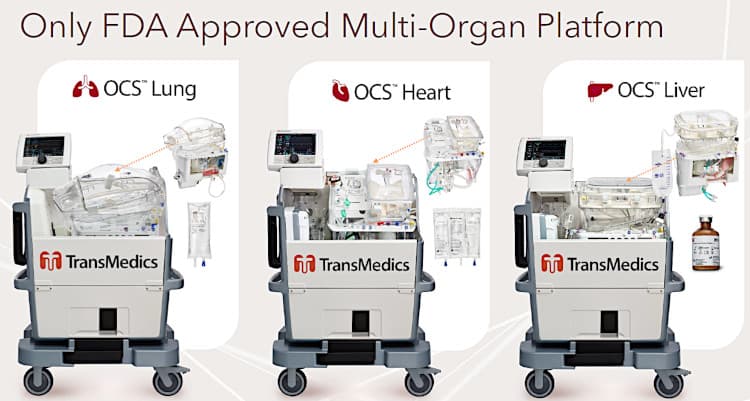TransMedics Stock Comes Alive with Organ Transplant Tech
Table of contents

Ever since we awakened to the fact that death is inevitable, humans have been trying to find ways to live forever. Until recently, our options have been pretty limited. One could choose to believe in some sort of afterlife and wait out the inevitable with varying levels of equanimity, but many of us would probably opt for some version of the Fountain of Youth. These days the quest for longevity has been taken up by the good knights of Silicon Valley. From sucking the blood of the young to harvesting human organs from pigs, companies are pushing technology (and sometimes ethics) to find ways to extend human life. One of the riskiest but most exciting sectors to emerge is regenerative medicine, a catch-all term for therapies that regenerate cells, tissues, and organs.
Regenerative medicine companies, for the most part, are a pretty speculative lot, and it’s a long shot that any of them will be successful commercially. That’s been especially true for those focused on technologies for organ replacements. For example, we’ve been following a 3D bioprinting company called Organovo (ONVO) since 2014. The biotech, which someday hopes to print entire organs, had a whopping $1.4 million in revenue for all of 2022. And while xenotransplantation – specifically, harvesting organs from genetically modified pigs for human recipients – is showing remarkable progress, we’re still years away from any sort of commercialization.

More than 100,000 people in the United States are awaiting a life-saving organ transplant at any given time. Meanwhile, nearly 15,000 died last year before they could get a new organ in time. That’s why biotech companies are burning through millions of dollars to someday bioprint or even grow new organs on demand. But what if the problem isn’t necessarily a lack of supply?
About TransMedics Stock
We recently became aware of TransMedics stock (TMDX) after the Boston area company’s revenues jumped more than 200% between 2021 and 2022. Today, it commands a market cap of $2.6 billion with $93.5 million in 2022 revenue. This is the kind of quarterly growth that the management team at Organovo would squeal over:

Yet TransMedics is not bioprinting piglets or growing hearts from genetically modified apple trees. It’s not a regenerative medicine company at all. Rather, it’s a medical equipment technology firm that’s been waiting 25 years to hit paydirt with its Organ Care System (OCS), an organ preservation platform.
A Warm-Blooded Organ Preservation System
One of the biggest bottlenecks of the current organ transplant system is procurement. This is the phase between harvesting a fresh organ from a donor and surgically inserting it into a waiting patient. Time is of the essence. A heart is only viable outside the body for up to six hours. Ditto for the lungs. An unpickled liver is good for up to 12 hours. The current standard for transporting fresh organs is to throw them on ice like beer. In contrast, OCS technology from TransMedics keeps the organs alive by replicating many aspects of their natural environment – the heart beats, the lungs breathe, the livers produce bile – while perfusing them with warm, oxygenated, nutrient-enriched blood.

In the case of a lung, for example, the OCS device can keep it viable for more than three times longer than a bag of ice. That means a donor on the west coast of the United States could help someone on the east coast of the country – though only over their dead body. The value proposition starts to come into focus when you realize (thanks to the marketing graphics from TransMedics) that distance is no longer a limiting factor. Suddenly, thousands of more hearts, lungs, and livers are in play:

In fact, if we are to believe these numbers, then clearing the organ donor waitlist is merely a matter of better preserving these organs. For example, there were about 3,500 people and one tinman waiting for a heart transplant in 2021, according to the Division of Transplantation (DoT) in the U.S. Department of Health and Human Services.

TransMedics implies that its OCS technology could more than meet that demand. Only about 1,000 people were waiting with bated breath for a lung transplant during the same timeframe. The system could also meet about half of all demand for new livers, with more than 11,600 people on the waiting list.
How Does TransMedics Make Money?
These aren’t exactly huge numbers in terms of volume, so it’s important to understand TransMedics’ total addressable market (TAM). A low TAM means the company’s meteoric revenue growth might burn out pretty quickly.
First, let’s briefly talk about how TransMedics actually makes money. The company employs a razor-and-blade business model. It basically rents the OCS consoles for free (some customers buy them outright) and then sells single-use, organ-specific disposable sets that are required for each transplant. These recurring revenues account for about 85% of total revenues, or about $79.2 million, though this probably includes some capital purchases of the consoles themselves. That’s the kind of percentage you want to see in these sorts of recurring revenue models.

The remainder of the company’s revenue comes from its National OCS Program (NOP), a turnkey service that provides outsourced organ retrieval and organ management. The company is leveraging this program to help spread its technology and add to the bottom line. Speaking of which: TransMedics has posted a consistent gross profit of 70% over the last two years, while also cutting losses over the last several quarters. In other words, the company appears to be running a pretty tight ship, especially at the clip it’s growing revenues.
What is the Total Addressable Market for TransMedics?
Back to our question: What is the total addressable market for preserving and transporting human organs? At least three different sources quote TransMedics as claiming an $8 billion TAM in its major markets: the United States, Canada, European Union, and Australia. That’s based on data released back in 2020 that said the average cost of a one-time OCS consumable was about $45,000. That works out to nearly 178,000 procedures.

Currently, about 90% of TransMedics revenues come from the United States, so let’s focus on that as the near-term market. In 2022, the company processed about 1,000 cases on OCS, representing only 7% of the existing total U.S. liver, heart, and lung transplants, according to TransMedics. Product sales accounted for about $79 million, as we noted earlier. If we subtract 10% for revenue generated outside of the United States, that leaves about $71 million, which again represents 7% of the total market. That means the existing TAM in the United States is only about $1 billion. But stick with us: Based on the earlier graphic on underutilized organs, TransMedics believes it can triple or even quadruple the number of transplants per year (at least for heart and lung). Let’s split the difference and call it 3.5 X $1 billion for a $3.5 billion TAM in the United States.
Let’s check our math by tackling the arithmetic from a totally different angle using data from the venerable consulting and actuarial firm Milliman, which specializes in healthcare and insurance. Milliman produced a very useful report a couple of years ago on the organ transplant market. It calculated the total cost of procurement (i.e., retrieval, preservation, and transportation) for each kind of organ per procedure.
- Heart – $131,500
- Liver – $104,200
- Lung – $118,900 (based on a crudely calculated average between single- and double-lung transplants)
This is exactly where TransMedics is competing with its OCS platform and NOP turnkey services. Some more back-of-napkin math: Multiply each of the numbers above with the total number of heart, liver, and lung transplants received and needed in 2022, based on figures from DoT:
| Heart | Liver | Lung | ||
| Procurement Cost per Organ | $131,500 | $104,200 | $118,900 | |
| Total Organs | 7,319 | 20,847 | 3,575 | |
| Total Cost | $962,448,500 | $2,172,257,400 | $425,067,500 | $3,559,773,400 |
That gives us a TAM of about $3.6 billion in the United States, which is nearly identical to our first estimate. Considering that the population in the company’s markets outside of the United States is about 1.5X as big, global TAM falls around $9 billion – not far off the original estimate from TransMedics.
Should You Buy TransMedics Stock?
We labored through this exercise because we want to know how much room TransMedics has to run before revenue starts to plateau. The answer: a lot. The company expects 2023 revenue between $138 million and $145 million, representing 48% to 55% growth compared to the previous year. That’s less than 2% of global TAM and about 4% of the U.S. market using the most optimistic revenue forecast.
Customer concentration is not a huge red flag, with only one customer accounting for 14% of 2022 revenues. Direct competition seems minimal, with just two companies offering similar platforms, according to TransMedics. OrganOx is a British startup with a similar setup for liver, and XVIVO Perfusion is a German biotech that’s been about as long as TransMedics and is specialized on lung transplants.

While all of this would seem to put TransMedics in a strong position, we have a few caveats. First, TransMedics itself notes that the cost of its OCS platform “significantly exceeds” the cost of cold storage preservation. How much? We don’t know, but it could negatively affect widespread adoption. It’s also not clear if the medical system is equipped to handle a two- or three-fold increase in transplants.
TransMedics has a pretty short history of this sort of growth, and it’s also not entirely clear how the company was suddenly able to pump up sales. If we were to invest – unlikely given that we’re already overweighted on life sciences in our Nanalyze Disruptive Tech Portfolio – we would want to wait and see if this is more than a flash in the pan.
In addition, the medtech company is overvalued. Using our simple valuation ratio, which divides current market cap ($2.6 billion) by annualized revenues ($31.4 million Q4-2022 X 4 = 125.6 million), we get 20.5. Our cut-off is 20, and no tech stocks worth owning are close to that right now.
Conclusion
After 25 years, TransMedics stock appears to be having its moment – but will it last? Sure, it’s “significantly” more expensive for organ preservation than the standard beer cooler. But how will it compare to the price tag for a bioprinted heart or one grown in a genetically modified pig, if and when someone finally reaches commercialization? If TransMedics can stay on this trajectory and maintain traction, the company could have a time horizon of a decade or two before other technologies are more economically feasible. We do know that there is no room in our tech portfolio for another life sciences company, especially at the current premium, but TransMedics stock is one to watch.
Sign up to our newsletter to get more of our great research delivered straight to your inbox!
Nanalyze Weekly includes useful insights written by our team of underpaid MBAs, research on new disruptive technology stocks flying under the radar, and summaries of our recent research. Always 100% free.
















Market cap, which one is it?
“Using our simple valuation ratio, which divides current market cap ($2.6 billion”
“Today, it commands a market cap of $4.5 billion”
Seems to be 2.6 billion
Good catch Hannu. It’s $2.6 as you said. Typo is fixed.
In the table above – Kidney seems to be a big number – Kidney transport could a big oppurtunity for tmdx
Q1 2023: revenue of $41.6M (+161.6% Y/Y). Net loss $2.6M, compared to $10.6M in Q1 2022. EPS: -$0.08.
Guidance: FY 2023 revenue of $160 million to $170 million.
Raised $400M with senior convertible notes having maturity date in 2028. Share price: ~$76, market cap: $2.5B.
Overall: TransMedics contines to impress, it is near profitable and I think it is going to do very well in the near future.
Lots of companies are magically swinging to profit now that raising capital has become quite difficult. Good to see they could raise $400 million.
TransMedics +51% yesterday after it announced better-than-expected financials for Q3 2023 and raised its full-year revenue outlook to a level above consensus.
Market has sure been rewarding on upsides lately